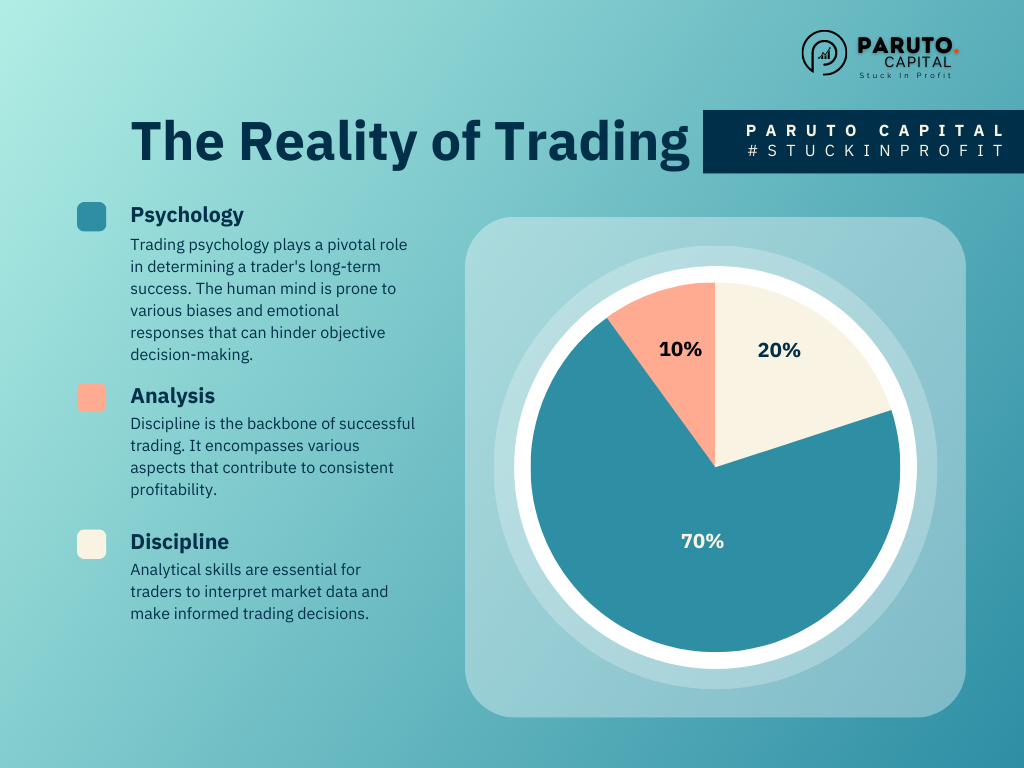Trading is a dynamic and complex endeavor that requires a combination of skills and attributes. While analysis and discipline play crucial roles in trading success, it is the psychological aspect that stands as the cornerstone. This article explores the reality of trading, with an emphasis on the significance of psychology in shaping a trader’s journey.
I.
Psychology: The Foundation of Trading: Psychology is the study of human behavior and mental processes, and its importance in trading cannot be overstated. The ability to understand and manage one’s emotions, biases, and cognitive processes is essential for making rational and disciplined trading decisions.
- Emotions and Trading: Emotions such as fear, greed, and euphoria often influence trading decisions. Fear can lead to hesitation or reluctance to take calculated risks, while greed may push traders into impulsive and irrational actions. Mastering emotional control is crucial in order to avoid making hasty and detrimental choices driven by fear or greed.
- Cognitive Biases: Human beings are susceptible to various cognitive biases, which can significantly impact trading outcomes. Confirmation bias, anchoring, and overconfidence are just a few examples. Being aware of these biases and actively working to overcome them is essential for making objective and unbiased trading decisions.
- Patience and Discipline: Trading requires patience, discipline, and the ability to stick to a well-defined trading plan. The psychological aspect of trading involves having the discipline to follow predetermined rules and strategies, even in the face of uncertainty and market fluctuations. Without discipline, traders may fall prey to impulsive decisions, leading to poor results.
II.
Discipline: The Bridge between Psychology and Analysis: Discipline acts as a bridge between psychology and analysis in trading, connecting the psychological aspect with the practical implementation of trading strategies. It is the ability to adhere to predetermined rules and strategies, which are formed through thorough analysis.
- Trading Plan: A robust trading plan encompasses various elements such as risk management, entry and exit strategies, and position sizing. Discipline is crucial in following this plan meticulously, avoiding the temptation to deviate based on emotions or impulsive decisions.
- Risk Management: Discipline plays a vital role in implementing effective risk management techniques. Setting stop-loss orders, adhering to risk-reward ratios, and controlling position sizes are all essential components of risk management. Without discipline, traders may neglect these crucial risk management practices, exposing themselves to excessive risks.
III.
Analysis: The Practical Component: Analysis forms the practical foundation of trading. It involves the study of market data, technical indicators, fundamental analysis, and other factors that influence market movements.
- Technical Analysis: Technical analysis involves the study of historical price patterns, chart patterns, and technical indicators to identify potential trading opportunities. It provides traders with a framework to make informed decisions based on market trends and patterns.
- Fundamental Analysis: Fundamental analysis focuses on assessing the intrinsic value of an asset by examining economic, financial, and qualitative factors. It helps traders determine the long-term potential of an investment and make decisions based on the underlying value of the asset.
While analysis and discipline are indispensable components of successful trading, it is the psychological aspect that underpins them both. Psychology governs a trader’s ability to remain calm, rational, and disciplined in the face of uncertainty and market fluctuations. By developing self-awareness, emotional control, and cognitive resilience, traders can enhance their decision-making processes and improve their chances of success in the dynamic world of trading.



